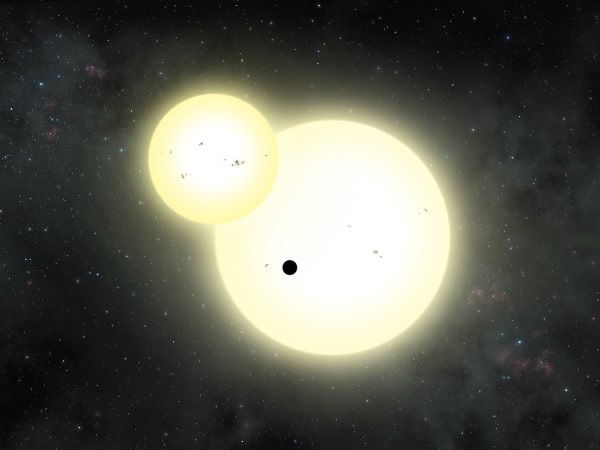Biggest Alien Planet Like 'Tatooine' Found Orbiting Two Suns
| Ana Verayo | | Jun 14, 2016 03:13 AM EDT |
(Photo : Lynette Cook/NASA) Artist's impression of the simultaneous stellar eclipse and planetary transit events on Kepler-1647.
Astronomers recently detected a Tatooine star system, similar to Luke Skywalker's home planet consisting of a gigantic exoplanet orbiting two stars. This planet known as Kepler-1647b which is also the largest planet ever discovered that is orbiting two suns that is classified as a circumbinary exoplanet.
Like Us on Facebook
Using NASA's Kepler Space Telescope, astronomers from NASA's Goddard Space Flight Center and San Diego State University announced yesterday this milestone discovery at the American Astronomical Society in San Diego, for their annual meeting.
Astronomers used a special technique with this telescope, where they search for dips in brightness that would indicate that a planet might be transiting in front of its star, which can block the light travelling from the star towards the direction of Earth.
According to co-author of the study, astronomer William Welsh from the San Diego State University, circumbinary planets are very difficult to find as opposed to searching for planets orbiting around single stars. Welsh says that these transits are also not regularly spaced in time, resulting in varying duration and depth.
Apart from this, researchers conducted crowd sourcing to also confirm the planet's existence with the use of a global network of professional and amateur astronomers.
Kepler-1647b can complete one orbit in a period of three years, where astronomers suggest that it is located in the habitable zone of its star system but is not a rocky planet like Earth but more of a gas planet similar to Jupiter and highly unlikely to host life.
This giant gas planet is located at a distance of 3,700 light years away from our solar system and is estimated at 4.4 billion years old, about the same age of Earth. It is also located in the Cygnus constellation but powerful telescopes are required in order to see it.
This new discovery will be published in the Astrophysical Journal.
Tagstatooine planet, jupiter like planet, planet orbiting two stars, planet orbiting two suns, Exoplanets
©2015 Chinatopix All rights reserved. Do not reproduce without permission
EDITOR'S PICKS
-

Did the Trump administration just announce plans for a trade war with ‘hostile’ China and Russia?
-

US Senate passes Taiwan travel bill slammed by China
-

As Yan Sihong’s family grieves, here are other Chinese students who went missing abroad. Some have never been found
-

Beijing blasts Western critics who ‘smear China’ with the term sharp power
-

China Envoy Seeks to Defuse Tensions With U.S. as a Trade War Brews
-

Singapore's Deputy PM Provides Bitcoin Vote of Confidence Amid China's Blanket Bans
-

China warns investors over risks in overseas virtual currency trading
-

Chinese government most trustworthy: survey
-

Kashima Antlers On Course For Back-To-Back Titles
MOST POPULAR
LATEST NEWS
Zhou Yongkang: China's Former Security Chief Sentenced to Life in Prison

China's former Chief of the Ministry of Public Security, Zhou Yongkang, has been given a life sentence after he was found guilty of abusing his office, bribery and deliberately ... Full Article
TRENDING STORY

China Pork Prices Expected to Stabilize As The Supplies Recover

Elephone P9000 Smartphone is now on Sale on Amazon India

There's a Big Chance Cliffhangers Won't Still Be Resolved When Grey's Anatomy Season 13 Returns

Supreme Court Ruled on Samsung vs Apple Dispute for Patent Infringement

Microsoft Surface Pro 5 Rumors and Release Date: What is the Latest?










